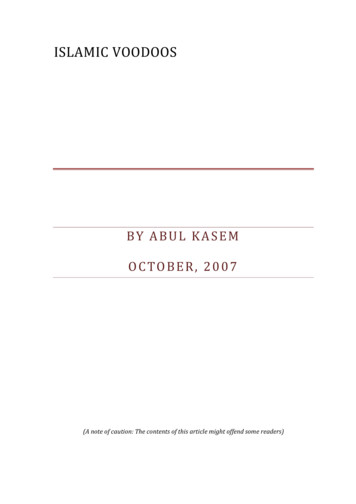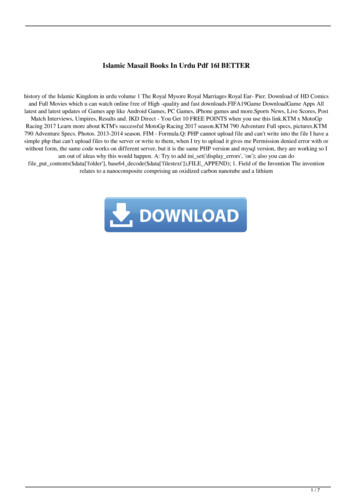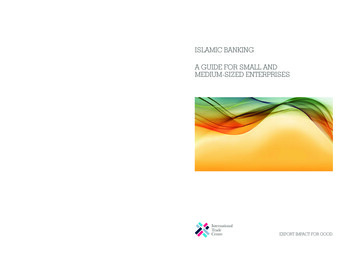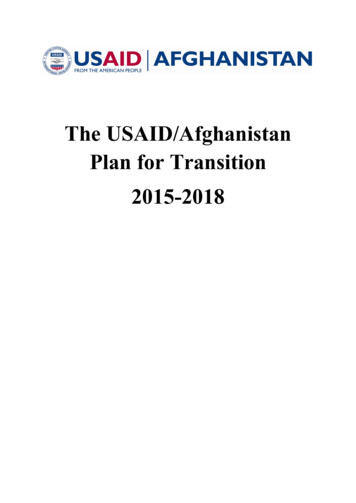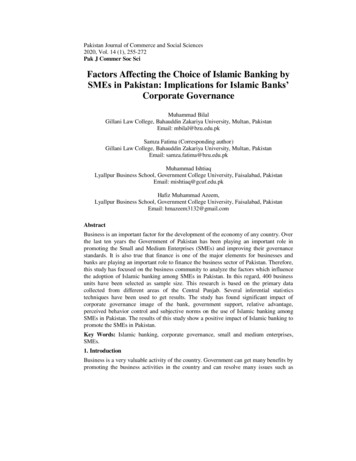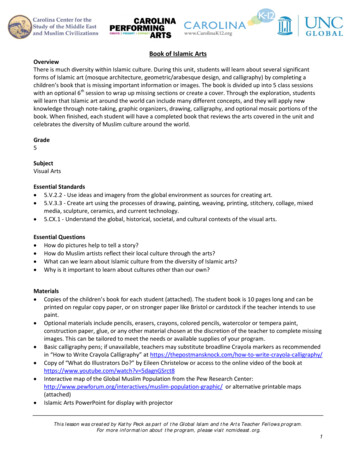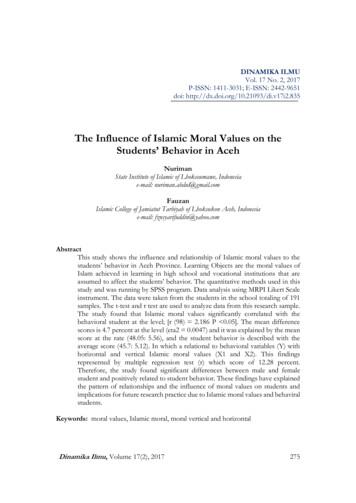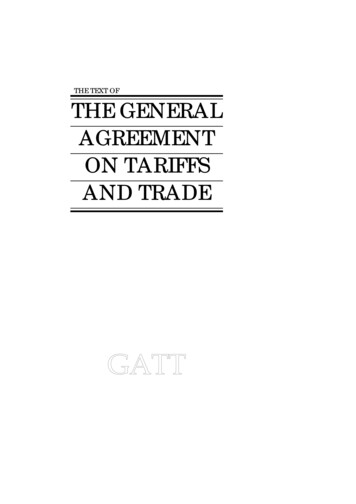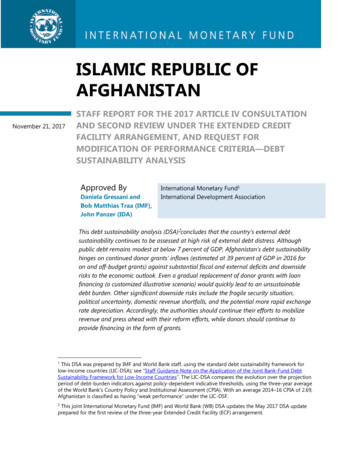
Transcription
ISLAMIC REPUBLIC OFAFGHANISTANNovember 21, 2017STAFF REPORT FOR THE 2017 ARTICLE IV CONSULTATIONAND SECOND REVIEW UNDER THE EXTENDED CREDITFACILITY ARRANGEMENT, AND REQUEST FORMODIFICATION OF PERFORMANCE CRITERIA—DEBTSUSTAINABILITY ANALYSISApproved ByDaniela Gressani andBob Matthias Traa (IMF),John Panzer (IDA)International Monetary Fund1International Development AssociationThis debt sustainability analysis (DSA)2concludes that the country’s external debtsustainability continues to be assessed at high risk of external debt distress. Althoughpublic debt remains modest at below 7 percent of GDP, Afghanistan’s debt sustainabilityhinges on continued donor grants’ inflows (estimated at 39 percent of GDP in 2016 foron and off-budget grants) against substantial fiscal and external deficits and downsiderisks to the economic outlook. Even a gradual replacement of donor grants with loanfinancing (a customized illustrative scenario) would quickly lead to an unsustainabledebt burden. Other significant downside risks include the fragile security situation,political uncertainty, domestic revenue shortfalls, and the potential more rapid exchangerate depreciation. Accordingly, the authorities should continue their efforts to mobilizerevenue and press ahead with their reform efforts, while donors should continue toprovide financing in the form of grants.This DSA was prepared by IMF and World Bank staff, using the standard debt sustainability framework forlow-income countries (LIC-DSA); see “Staff Guidance Note on the Application of the Joint Bank-Fund DebtSustainability Framework for Low-Income Countries”. The LIC-DSA compares the evolution over the projectionperiod of debt-burden indicators against policy-dependent indicative thresholds, using the three-year averageof the World Bank’s Country Policy and Institutional Assessment (CPIA). With an average 2014–16 CPIA of 2.69,Afghanistan is classified as having “weak performance” under the LIC-DSF.1This joint International Monetary Fund (IMF) and World Bank (WB) DSA updates the May 2017 DSA updateprepared for the first review of the three-year Extended Credit Facility (ECF) arrangement.2
ISLAMIC REPUBLIC OF AFGHANISTANBACKGROUNDOver the past years, Afghanistan’s government has relied mainly on grant financing andlimited concessional borrowing to finance its development needs. At end-2016, Afghanistan’s totalreported public external debt stood at US 1,240 million or 6.3 percent of GDP. The low level of debt is theresult of past debt relief under the Enhanced HIPC Initiative, additional debt cancellation from Paris Clubcreditors, and little borrowing since then.3 The borrowing comes mostly from multilateral institutions and ismainly denominated in U.S. dollars and euros. There is no borrowing from the domestic market, except foroutstanding debt to DAB that is related to the resolution of the Kabul Bank crisis. In addition to the AsianDevelopment Bank (ADB) and the International Development Agency (IDA), other multilateral creditorsinclude the International Monetary Fund (IMF), and the Islamic Development Bank (IsDB). Among thebilateral creditors, the Saudi Fund was the main creditor (5 percent of total debt outstanding) followed bythe Kuwait Fund (2 percent).The overall risk is somewhat mitigatedby the maturity structure of the portfolio.Overall, the cost of the reported loan portfolio ismanageable. The current annual interest paymentis lower than 0.1 percent of GDP. The entireportfolio bears fixed interest rates. The averagetime to maturity is 14 years. The redemption profileshows stable principal payments throughout theperiod. The main risk is the exchange ratedepreciation since the entire portfolio isdenominated in foreign currency. But this risk ismitigated by the long repayment periods of theconcessional borrowing.External Public Debt by Currency(End-2016; In percent)Other17%GBP6%USD44%JPY7%EUR26%Sources: Afghan authorities.Public debt recording and monitoring needs to be strengthened. The latest IMF assessment ofpublic debt recording and monitoring capacity, made in consultation with the World Bank(November 2016), pointed to the need to build stronger capacity in this area. The scope of the current DSAis the central government debt. The financial balance of some thirty-six state-owned enterprises (SOEs) andsixteen state-owned corporations (SOCs) and the associated risks for the government are not centrally andeffectively monitored, as their operational functions are supervised through their respective line ministries.The government provides support to SOEs and SOCs in the form of loans, guarantees, concessions, taxexpenditures, subsidies, and recapitalizations.4 An increasing number of infrastructure projects will likelyinvolve sovereign financing and guarantees, particularly in the electricity sector. Progress on debt recordingand monitoring, including on-lending by the government, would require further technical assistance andtraining with the aim to ensure full consistency between debt servicing and budget and liquidity planning.This debt stock is after delivery of the already-pledged debt relief commitments. Afghanistan is still following upwith one Paris Club creditor on its debt relief commitments (US 900 billion). The delay with the Paris Club creditor isdue to a technical reason and the debt relief is expected to be finalized by the end of the year.342Conversely, anecdotal information indicates that the government runs some arrears vis-à-vis SOEs & SOCs.INTERNATIONAL MONETARY FUND
ISLAMIC REPUBLIC OF AFGHANISTANSome progress is expected to come from the rolling out of a Medium-Term Debt Strategy (MTDS) for2017–19, supported by World Bank assistance. The World Bank is also involved in a project on assessingSOEs’ financial position.UNDERLYING DSA ASSUMPTIONSThe DSA’s baseline macroeconomic scenario 2017-2037 assumes a gradual increase fromthe near-term projection of 3–4 percent to the estimated growth potential of 6 percent beyond afive-year projection period.5 Staffs projects lower average growth over 2016–20 than in the May 2017 update owing todownward revisions of growth in 2017–18 reflecting the short- and medium-term uncertainties.Given persistent security challenges, the point at which this growth potential is assumed to bereached has been pushed into the future. Post–2024 growth is assumed to remain at itspotential of 6 percent.6 Over time, stronger growth and job creation are assumed to be supported by extractiveindustries, agricultural development, public investment in education and health, and regionaltrade integration. If security conditions worsen, aid falls short, or reforms stall, growth would belower with attendant effects on unemployment and poverty. Alternatively, lasting peace withinsurgents would boost private sector confidence and facilitate a shift in public spending fromsecurity to development, leading to higher and more inclusive growth.Macroeconomic Assumptions Comparison TableDSA update May 20172016-202021-37DSA October 20172016-20Current vs. previous2021-37Medium termLong termReal growth (%)3.45.03.15.8-0.30.8Inflation (GDP, deflator, ue and grants (% GDP)27.126.826.026.7-1.1-0.1Grants (% GDP)15.811.115.010.9-0.8-0.2Primary expenditure (% GDP)27.028.325.927.0-1.1-1.3Primary deficit (% GDP)-0.11.5-0.10.30.0-1.2Exports of G&S (% GDP)6.59.77.011.80.52.0Noninterest current account balance (%GDP)3.8-3.13.8-6.90.0-3.8Nominal GDP (Billions of Afghanis)Sources: Afghan authorities; and IMF staff estimates and projections.This assumption is based on growth accounting and is consistent with the analysis by the World Bank thatemphasizes development of agriculture and extractive industries, public investment in education and health, andregional integration.56The DSA is based on the medium-term baseline scenario of the second review of the arrangement under the ECF.INTERNATIONAL MONETARY FUND3
ISLAMIC REPUBLIC OF AFGHANISTAN As in the previous DSA, the scenario incorporates a gradual decline in donor aid with anincreasing share being disbursed through the budget and provided to the civilian sector. HigherGDP growth results in lower grant-to-GDP ratios with a corresponding decrease in expenditureto-GDP ratios, thus keeping positive primary balances. The underlying assumption of thisscenario is long-run improvements of security and political stability. Export growth is slightly higher in the revised long-term scenario based on completion of theongoing regional infrastructure/trade projects. The long-term agenda aiming at diversifying theeconomy as well as progress with regional integration should result in attracting FDIs intotradable sectors. Growing FDIs (mining, services—transport infrastructure, banking,communication, distribution) will contribute to covering the widening current account deficitstemming from declining grants.The potential for increased domestic revenue is strengthening. Despite impressive progress inrecent years, the Afghan government has a pressingGrants and Domestic Revenue 2017-37need to increase revenues to meet its security and(In percent of GDP)25development goals. Further improvements areOn-budget grantsOff-budget grantspossible; the World Bank estimates that the revenue20Domestic Revenuepotential is around 60 percent above current levels.15Two complementary policies stand out as ways to10achieve higher revenues: establishing a modern LargeTaxpayers Office (LTO) and replacing the current5Business Receipts Tax (BRT) with a value-added tax0(VAT) levied on LTO firms. In addition, transit fees-5could be collected from Afghanistan’s participation in2017 2019 2021 2023 2025 2027 2029 2031 2033 2035 2037major regional energy trade projects.Sources: Afghan authorities and IMF projections.EXTERNAL DSAAssuming continued donor support in theform of grants, Afghanistan's debt outlook isbenign. Afghanistan's public debt remains modest.External public and publicly guaranteed debt, mostlyto multilateral creditors, amounted to 6.3 percent ofGDP in 2016. A limited amount of concessionalborrowing (US 18 million from a bilateral creditor)and a non-concessional loan from the IslamicDevelopment Bank (US 75 million) linked to largeinfrastructure projects with potentially high rates ofeconomic and social returns were contracted in 2017.4INTERNATIONAL MONETARY FUNDExternal Debt Contracted in 20171/P P G e xte rna l de bt c ontra c te dor gua ra nte e dV olume of ne w de bt,US D millionS ourc e s of de bt fina nc ingMultilateral, semi- c onc essional debt 2/75Bilateral, c onc essional18Use s of de bt fina nc ingInfrastruc tureBudget financ ing9301/ A s o f end-Octo ber 2017.2/ Debt with a po sitive grant element which do es no t meet the minimum grantelement o f 60 percent.
ISLAMIC REPUBLIC OF AFGHANISTANModerate external borrowing is planned in the short run. The authorities have not yetestablished an annual borrowing plan. They expect a moderate amount of additional net concessionalborrowing to take place during 2017–19 including two loans of EUR 7 million for road construction andEUR 65 million for railway construction from a Paris Club creditor in line with the current policy ofborrowing only for infrastructure projects.A change in the structure of financing with a shift of 15 percent of grants towardsconcessional lending from 2020 onward would put Afghanistan at a high risk of external debtdistress. Under such a scenario, the threshold for the present value of debt to exports ratio is breached andthe dynamics for other solvency and liquidity indicators deteriorate post-2020.7PUBLIC DSAThe baseline scenario assumes that the government will issue domestic public debt in themid-2020s. The only domestic component of public debt (1.7 percent of GDP in 2016) is currentlya promissory note issued by the Ministry of Finance in 2012 to underwrite DAB’s lender-of-last-resortexposure to Kabul Bank; consistent with the structural conditionality of the ECF, it is expected to be fullyrepaid through capital transfers to DAB by end-2019. The country is assumed to start issuing domesticpublic debt (sukuk) during the forthcoming decade at moderate levels (about 0.2 percent of GDP) beforegradually increasing this source of financing along the forecast period. A sukuk law and operationalframework is under preparation with the help of the IsDB.AUTHORITIES’ VIEWSThe authorities agreed with the conclusions of the DSA. They remain committed to ensuringdebt sustainability and to relying on donor grants and limited concessional borrowing. They nonethelessemphasized the country’s very large financing needs to boost growth and job creation. The authoritieswould welcome targeted TA on recording and monitoring public debt and fiscal risks in the context of theimplementation of PPPs, as well as assistance for the introduction of sukuk. The government intends to usesukuks as a liquidity management instrument, to finance its development and possibly recurrent spending.7The scenario is subject to high uncertainties regarding the sources and uses of grants and concessional borrowing.INTERNATIONAL MONETARY FUND5
ISLAMIC REPUBLIC OF AFGHANISTANCONCLUSIONSAfghanistan’s debt sustainability hinges on continued donor grant inflows. The debt outlookunder the baseline scenario is benign. However, a change in the structure of donor financing with a shift toloans as shown in the customized scenario would quickly lead to an unsustainable debt burden. Hence,Afghanistan remains at a high risk of external debt distress. Reducing dependence on external financingrequires expanding the tax base and further strengthening revenue collection. The authorities’ capacity toplan, evaluate and contract borrowing, and to monitor debt and fiscal risks needs to be strengthened. Thisincludes adequate accounting of government guarantees which may emerge from private-publicpartnerships. Establishing a database of ongoing and potential infrastructure projects that may involvepublic debt and guarantees is also needed. For the time being, Afghanistan’s financing needs need to bemet with donor grants and highly concessional external borrowing (grant element of at least 60 percent) tomeet foreign-currency denominated obligations.6INTERNATIONAL MONETARY FUND
ISLAMIC REPUBLIC OF AFGHANISTANFigure 1. Afghanistan: Indicators of Public and Publicly Guaranteed External Debt UnderAlternatives Scenarios, 2017–37 1/a. Debt 12642020172022202720322037b.PV of debt-to GDP ratio20172022202720322037Rate of Debt AccumulationGrant-equivalent financing (% of GDP)Grant element of new borrowing (% right scale)c.PV of debt-to-exports ratio300d.PV of debt-to-revenue 2037e.Debt service-to-exports ratio16020172022202720322037f.Debt service-to-revenue hreshold20272032203720172022202720322037Most extreme shock 1/Custom: Low GrantSources: Country authorities; and staff estimates and projections.1/ The most extreme stress test is the test that yields the highest ratio on or before 2027.INTERNATIONAL MONETARY FUND7
ISLAMIC REPUBLIC OF AFGHANISTANFigure 2. Afghanistan: Indicators of Public Debt Under Alternative Scenarios, 2017–37 1/BaselineHistorical scenarioMost extreme shock 1/Fix Primary BalancePublic debt benchmarkLow Grant40PV of Debt-to-GDP 3320352037PV of Debt-to-Revenue Ratio 2/120100806040200201720192021202320256Debt Service-to-Revenue Ratio543210201720192021202320252027Sources: Country authorities; and staff estimates and projections.1/ The most extreme stress test is the test that yields the highest ratio on or before 202 72/ Revenues are defined inclusive of grants.8INTERNATIONAL MONETARY FUND
ISLAMIC REPUBLIC OF AFGHANISTANTable 1a. Afghanistan: External Debt Sustainability Framework, Baseline Scenario,2014–37 1/(In percent of GDP, unless otherwise indicated)ActualExternal debt (nominal) 1/of which: public and publicly guaranteed (PPG)Change in external debtIdentified net debt-creating flowsNon-interest current account deficitDeficit in balance of goods and servicesExportsImportsNet current transfers (negative inflow)of which: officialOther current account flows (negative net inflow)Net FDI (negative inflow)Endogenous debt dynamics 2/Denominator: 1 g r grContribution from nominal interest rateContribution from real GDP growthContribution from price and exchange rate changesResidual (3-4) 3/of which: exceptional financingPV of external debt 4/In percent of exportsPV of PPG external debtIn percent of exportsIn percent of government revenuesDebt service-to-exports ratio (in percent)PPG debt service-to-exports ratio (in percent)PPG debt service-to-revenue ratio (in percent)Total gross financing need (Billions of U.S. dollars)Non-interest current account deficit that stabilizes debt .6-0.5-0.11.10.0-0.1 .5-0.11.10.0-0.2 .5-0.21.10.0-0.2 0.5-0.21.10.0-0.2 0.5-0.21.10.0-0.3 .9-0.21.10.0-0.3 .239.0-32.2-31.0-0.5-0.6-0.21.10.0-0.2 1-0.31.10.0-0.3 -0.31.10.1-0.3 .0Key macroeconomic assumptionsReal GDP growth (in percent)GDP deflator in US dollar terms (change in percent)Effective interest rate (percent) 5/Growth of exports of G&S (US dollar terms, in percent)Growth of imports of G&S (US dollar terms, in percent)Grant element of new public sector borrowing (in percent)Government revenues (excluding grants, in percent of GDP)Aid flows (in Billions of US dollars) 7/of which: Grantsof which: Concessional loansGrant-equivalent financing (in percent of GDP) 8/Grant-equivalent financing (in percent of external financing) 8/Memorandum items:Nominal GDP (Billions of US dollars)Nominal dollar GDP growthPV of PPG external debt (in Billions of US dollars)(PVt-PVt-1)/GDPt-1 (in percent)Gross workers' remittances (Billions of US dollars)PV of PPG external debt (in percent of GDP remittances)PV of PPG external debt (in percent of exports remittances)Debt service of PPG external debt (in percent of exports remittances)1.30.90.90.1Sources: Country authorities; and staff estimates and projections.1/ Includes both public and private sector external debt.2/ Derived as [r - g - ρ(1 g)]/(1 g ρ gρ) times previous period debt ratio, with r nominal interest rate; g real GDP growth rate, and ρ growth rate of GDP deflator in U.S. dollar terms.3/ Includes exceptional financing (i.e., changes in arrears and debt relief); changes in gross foreign assets; and valuation adjustments. For projections also includes contribution from price and exchange rate changes.4/ Assumes that PV of private sector debt is equivalent to its face value.5/ Current-year interest payments divided by previous period debt stock.6/ Historical averages and standard deviations are generally derived over the past 10 years, subject to data availability.7/ Defined as grants, concessional loans, and debt relief.8/ Grant-equivalent financing includes grants provided directly to the government and through new borrowing (difference between the face value and the PV of new debt).INTERNATIONAL MONETARY FUND9
ISLAMIC REPUBLIC OF AFGHANISTANTable 1b. Afghanistan: Sensitivity Analysis for Key Indicators of Public and PubliclyGuaranteed External Debt, 2017–37(In 182421181424PV of debt-to GDP ratioBaselineA. Alternative ScenariosA1. Key variables at their historical averages in 2016-2036 1/A2. New public sector loans on less favorable terms in 2016-2036 2A3. Alternative Scenario: Low GrantB. Bound TestsB1. Real GDP growth at historical average minus one standard deviation in 2017-2018B2. Export value growth at historical average minus one standard deviation in 2017-2018 3/B3. US dollar GDP deflator at historical average minus one standard deviation in 2017-2018B4. Net non-debt creating flows at historical average minus one standard deviation in 2017-2018 4/B5. Combination of B1-B4 using one-half standard deviation shocksB6. One-time 30 percent nominal depreciation relative to the baseline in 2017 5/PV of debt-to-exports ratioBaselineA. Alternative ScenariosA1. Key variables at their historical averages in 2016-2036 1/A2. New public sector loans on less favorable terms in 2016-2036 2A3. Alternative Scenario: Low GrantB. Bound TestsB1. Real GDP growth at historical average minus one standard deviation in 2017-2018B2. Export value growth at historical average minus one standard deviation in 2017-2018 3/B3. US dollar GDP deflator at historical average minus one standard deviation in 2017-2018B4. Net non-debt creating flows at historical average minus one standard deviation in 2017-2018 4/B5. Combination of B1-B4 using one-half standard deviation shocksB6. One-time 30 percent nominal depreciation relative to the baseline in 2017 5/PV of debt-to-revenue ratioBaselineA. Alternative ScenariosA1. Key variables at their historical averages in 2016-2036 1/A2. New public sector loans on less favorable terms in 2016-2036 2A3. Alternative Scenario: Low GrantB. Bound TestsB1. Real GDP growth at historical average minus one standard deviation in 2017-2018B2. Export value growth at historical average minus one standard deviation in 2017-2018 3/B3. US dollar GDP deflator at historical average minus one standard deviation in 2017-2018B4. Net non-debt creating flows at historical average minus one standard deviation in 2017-2018 4/B5. Combination of B1-B4 using one-half standard deviation shocksB6. One-time 30 percent nominal depreciation relative to the baseline in 2017 5/10INTERNATIONAL MONETARY FUND
ISLAMIC REPUBLIC OF AFGHANISTANTable 1b. Afghanistan: Sensitivity Analysis for Key Indicators of Public and PubliclyGuaranteed External Debt, 2017–37 (continued)(In percent)Debt service-to-exports 26262A. Alternative ScenariosA1. Key variables at their historical averages in 2016-2036 1/A2. New public sector loans on less favorable terms in 2016-2036 2A3. Alternative Scenario: Low GrantB. Bound TestsB1. Real GDP growth at historical average minus one standard deviation in 2017-2018B2. Export value growth at historical average minus one standard deviation in 2017-2018 3/B3. US dollar GDP deflator at historical average minus one standard deviation in 2017-2018B4. Net non-debt creating flows at historical average minus one standard deviation in 2017-2018 4/B5. Combination of B1-B4 using one-half standard deviation shocksB6. One-time 30 percent nominal depreciation relative to the baseline in 2017 5/Debt service-to-revenue ratioBaselineA. Alternative ScenariosA1. Key variables at their historical averages in 2016-2036 1/A2. New public sector loans on less favorable terms in 2016-2036 2A3. Alternative Scenario: Low GrantB. Bound TestsB1. Real GDP growth at historical average minus one standard deviation in 2017-2018B2. Export value growth at historical average minus one standard deviation in 2017-2018 3/B3. US dollar GDP deflator at historical average minus one standard deviation in 2017-2018B4. Net non-debt creating flows at historical average minus one standard deviation in 2017-2018 4/B5. Combination of B1-B4 using one-half standard deviation shocksB6. One-time 30 percent nominal depreciation relative to the baseline in 2017 5/Memorandum item:Grant element assumed on residual financing (i.e., financing required above baseline) 6/Sources: Country authorities; and staff estimates and projections.1/ Variables include real GDP growth, growth of GDP deflator (in U.S. dollar terms), non-interest current account in percent of GDP, and non-debt creating flows.2/ Assumes that the interest rate on new borrowing is by 2 percentage points higher than in the baseline., while grace and maturity periods are the same as in the baseline.3/ Exports values are assumed to remain permanently at the lower level, but the current account as a share of GDP is assumed to return to its baseline level after the shock(implicitly assuming an offsetting adjustment in import levels).4/ Includes official and private transfers and FDI.5/ Depreciation is defined as percentage decline in dollar/local currency rate, such that it never exceeds 100 percent.6/ Applies to all stress scenarios except for A2 (less favorable financing) in which the terms on all new financing are as specified in footnote 2.INTERNATIONAL MONETARY FUND11
INTERNATIONAL MONETARY 3.83.8.3.73.73.7.3.63.63.6.3.53.53.5.2.1 0Real GDP growth (in e nominal interest rate on forex debt (in percent)Average real interest rate on domestic debt (in percent)Real exchange rate depreciation (in percent, indicates depreciation)Inflation rate (GDP deflator, in percent)Growth of real primary spending (deflated by GDP deflator, in .3 -0.96.31.70.1 0.5.6.08.90.6.6.07.60.5. .6.06.4.38.738.7 45.654.156.960.059.659.5Public sector debt 1/of which: foreign-currency denominatedChange in public sector debtIdentified debt-creating flowsPrimary deficitRevenue and grantsof which: grantsPrimary (noninterest) expenditureAutomatic debt dynamicsContribution from interest rate/growth differentialof which: contribution from average real interest rateof which: contribution from real GDP growthContribution from real exchange rate depreciationOther identified debt-creating flowsPrivatization receipts (negative)Recognition of implicit or contingent liabilitiesDebt relief (HIPC and other)Other (specify, e.g. bank recapitalization)Residual, including asset .12037Average6.50.4Other Sustainability Indicators
2017-19, supported by World Bank assistance. The World Bank is also involved in a project on assessing SOEs' financial position. UNDERLYING DSA ASSUMPTIONS The DSA's baseline macroeconomic scenario 2017-2037 assumes a gradual increase from the near-term projection of 3-4 percent to the estimated growth potential of 6 percent beyond a
